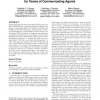281 search results - page 20 / 57 » Planning with Partial Preference Models |
HCI
2009
13 years 6 months ago
2009
Sign language (SL) recognition modules in human-computer interaction systems need to be both fast and reliable. In cases where multiple sets of features are extracted from the SL d...
UIST
2003
ACM
14 years 1 months ago
2003
ACM
People use their awareness of others' temporal patterns to plan work activities and communication. This paper presents algorithms for programatically detecting and modeling t...
WSC
2008
2008
Simulating order fulfillment and supply planning for a vertically aligned industry solution business
13 years 10 months ago
We model supply chain of an industry solution equipment manufacturer, where the merchandise is sold worldwide, but suppliers are mostly located in Asia. The preferred shipment of ...
PKDD
2009
Springer
14 years 3 months ago
2009
Springer
Probabilistic relational models are an efficient way to learn and represent the dynamics in realistic environments consisting of many objects. Autonomous intelligent agents that gr...
ATAL
2006
Springer
14 years 6 days ago
2006
Springer
Decentralized partially observable Markov decision processes (DEC-POMDPs) form a general framework for planning for groups of cooperating agents that inhabit a stochastic and part...



